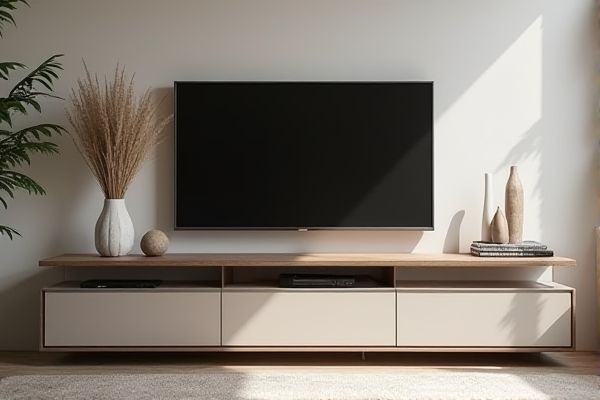
A media cabinet offers concealed storage options for electronics and accessories, reducing clutter, while a TV stand primarily provides an open platform designed to support your television and display decorative items. Explore the rest of the article to discover which option best suits your living space and entertainment needs.
Table of Comparison
| Feature | Media Cabinet | TV Stand |
|---|---|---|
| Primary Use | Storage for media devices, accessories, and DVDs | Support and display of TV sets |
| Storage Capacity | High, includes shelves, drawers, and compartments | Limited, usually open shelves or cabinets |
| Design | Enclosed design to hide equipment | Open or minimalistic design |
| Size | Larger and bulkier for more storage | Compact and space-saving |
| Functionality | Organizes multiple media components | Primarily supports TV, some storage |
| Material | Wood, MDF, or metal with finishes | Varies: wood, glass, metal |
| Price Range | Moderate to high depending on size and features | Low to moderate |
Media Cabinet vs TV Stand: Key Differences
A media cabinet offers enclosed storage with shelves and doors, ideal for organizing electronics, DVDs, and accessories, while a TV stand primarily supports the television and may have limited storage options. Media cabinets often feature cable management systems and adjustable shelving to accommodate various media devices, unlike TV stands that focus more on design and minimalism. Your choice depends on whether you prioritize extensive storage and organization or a simple platform for your TV.
Design and Aesthetic Appeal
Media cabinets often feature sleek, enclosed designs with customizable shelves and cable management options, enhancing a clean and modern aesthetic. TV stands typically provide open shelving and minimalist frames, highlighting the television and facilitating easy access to media devices. Both designs prioritize blending functionality with style, allowing homeowners to match their entertainment setup with varied interior decor themes.
Storage Capacity and Organization
Media cabinets offer significantly more storage capacity and organization options compared to TV stands, featuring multiple shelves, drawers, and compartments designed to store electronic devices, DVDs, and accessories neatly. TV stands typically provide a simpler design with limited storage, often just enough space for a cable box or gaming console beneath the television. Choosing a media cabinet can enhance your room's organization and keep all your entertainment essentials within easy reach while maintaining a clutter-free environment.
Functionality and Versatility
Media cabinets offer enhanced functionality with built-in compartments specifically designed for housing electronic devices, cable management, and additional storage for media accessories, providing a clutter-free entertainment space. TV stands prioritize versatility by supporting various television sizes and styles, often incorporating open shelves or simple storage options for easy access and flexible arrangement. Choosing between the two depends on the need for organized media storage versus adaptable TV display solutions.
Space Requirements and Room Suitability
Media cabinets typically require more space due to their enclosed storage and larger dimensions, making them suitable for spacious living rooms or dedicated entertainment areas. TV stands often feature minimalist designs with smaller footprints, ideal for compact rooms or apartments where maximizing floor space is essential. Selecting between the two depends on room size, storage needs, and the desired aesthetic impact on the living environment.
Material and Build Quality
Media cabinets typically feature robust materials such as solid wood or engineered wood with reinforced joints, providing enhanced durability and support for heavier electronic equipment. TV stands often use lighter materials like MDF or particleboard with laminate finishes, prioritizing affordability and modern aesthetics but potentially compromising long-term sturdiness. High-quality media cabinets often include custom finishes and sturdier hardware, ensuring better protection for AV components compared to standard TV stands.
Cable Management Solutions
Media cabinets typically offer superior cable management solutions compared to TV stands, featuring built-in grommets, cable channels, and hidden compartments to organize wires discreetly. TV stands may provide basic openings for cables, but often lack the comprehensive design elements necessary to conceal and manage multiple cables from devices like sound systems, gaming consoles, and streaming boxes. Effective cable management in media cabinets reduces clutter, improves safety, and enhances the overall aesthetic of home entertainment setups.
Compatibility with Modern Electronics
Media cabinets typically offer greater compatibility with modern electronics due to their spacious compartments and built-in cable management systems designed to accommodate gaming consoles, streaming devices, and soundbars. TV stands often prioritize minimalist designs that may limit the space and ventilation necessary for multiple contemporary electronic components. Choosing a media cabinet can enhance your setup by providing organized storage and better airflow for your devices.
Price Comparison and Budget Considerations
Media cabinets typically range from $150 to $700 depending on size, materials, and features, while TV stands often start as low as $50 and can go up to $400. For budget-conscious buyers, TV stands offer a more affordable option with basic functionality, whereas media cabinets provide additional storage and a polished look at a higher price point. Evaluating both options involves considering the balance between cost, storage needs, and aesthetic preferences to ensure the best value within your budget.
Choosing the Right Option for Your Home
A media cabinet offers ample storage with enclosed compartments ideal for organizing electronics, DVDs, and gaming accessories, making it perfect for households seeking clutter-free spaces. A TV stand typically provides a simple, open design that emphasizes the display of the television and easy access to connected devices, suitable for smaller rooms or minimalist decor. Consider room size, storage needs, and aesthetic preferences to select the option that best enhances your home entertainment setup.
 homyna.com
homyna.com